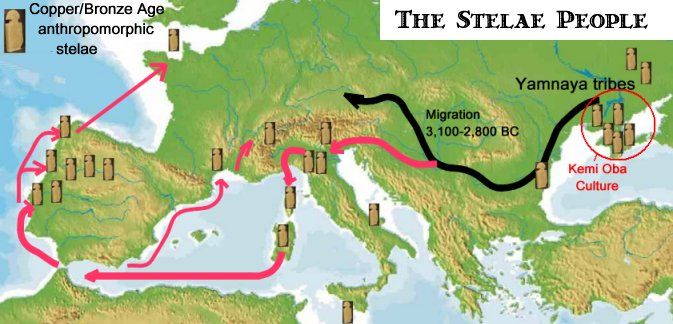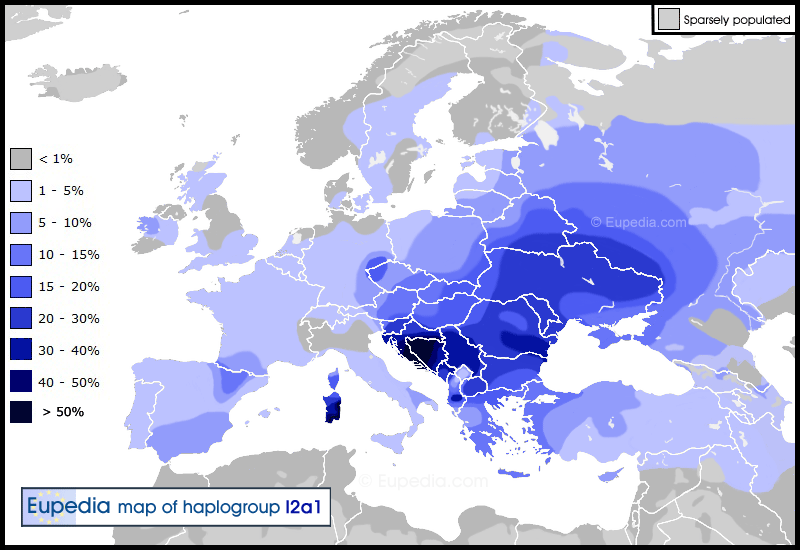Anthro-inclined
Regular Member
How is this relevant to this thread? There was also an Albanian kingdom in the Caucasus, but it didnt have anything to do with modern Albania. Its just a name.
Follow along with the video below to see how to install our site as a web app on your home screen.

Note: This feature currently requires accessing the site using the built-in Safari browser.
How is this relevant to this thread? There was also an Albanian kingdom in the Caucasus, but it didnt have anything to do with modern Albania. Its just a name.
This map shows that the three major west european clades (blue U152, darkblue S116, green U106) all already occur in Ukraine and the east Pontic coast but there together with ancestral clade (red L23). This suggests a route from east black sea coast -> east europe/balkans -> cenral europe -> WE. Although this is not so apparent for the "Italian" blue clade U152, which could have a more southern history too.
The oldest one (M269 brown) stretches from Iran, Anatolia and Balkans.
I wonder why no other R1b variants have developed in the near east and Anatolia, given that there are the oldest clades.
Maybe R1b came from the Balkans, since all of the older and most newer clades occur there?
| 13 | 23 | 16 | 10 | 11-15 | 13 | 12 | 11 | 14 | 13 | 31 | 15 | 9-9 | 11 | 11 | 26 | 14 | 20 | 31 | 12-15-15-16 | 11 | 12 | 21-23 | 16 | 16 | 18 | 18 | 31-37 | 13 | 11 |
Uploaded with ImageShack.us
are these R1b breakups form 2012 survey dead?
note - I am amazed by the "purity" of the NEItaly/east austrian area

Sorry, this map is what I mean.


Uploaded with ImageShack.us
are these R1b breakups form 2012 survey dead?
note - I am amazed by the "purity" of the NEItaly/east austrian area
There is no doubt all R1b in Iberia is either from Celtic migrations 2,700ybp or a earlier Celtic or Italo Celtic migration. a language is just a language i already told u that Basque ancestors where Celts but they did not speak a Celtic language. The reason Indo Europeans spread their language and Y DNA is because they conquered people. They killed off the old y dna and brought their Y DNA because men fight in wars and they became the hierarchy in the society like when the Aryans conquered India they made themselves the High caste.
For Basque for some reason they where able to keep the native language. In eastern Iberia they never spoke a Celtic language but they probably where still very Celtic in culture. Those ares have the highest I2a1a there is some written records of non Celtic languages from east Iberia i bet there related to Basque.
While it is true that (almost) every rule has an exception, when it has 3, 4 exceptions, you start wondering about the rule.
the Basques' ancestors originally spoke an Italo-Celtic language before arriving in the Pyrenees, where they mysteriously dropped their language,

I agree that R-P312 is intimately associated with Celtic languages, and that it's plausible that the Basques' ancestors originally spoke an Italo-Celtic language before arriving in the Pyrenees, where they mysteriously dropped their language, in spite of their conquerors' status.
On the other hand, the R1b-IE connection seems to have several flaws, namely the Basque/Aquitanian language and the Iberian language in the peninsula's most R1b-saturated regions, plus the Etruscan language in ancient Etruria, which is the Italian region with the highest concentration of R-U152. Why were those R1b conquerors so ready to drop their mother tongue(s), in several different places? There is no parallel among R1a populations, for instance.
While it is true that (almost) every rule has an exception, when it has 3, 4 exceptions, you start wondering about the rule.
I wonder too if non IE languages like Basque and Iberian weren't descended from the language spoken by the Bell Beakers. As a theory, Bell Beakers carrying some early clad of r1b like L23 or L51 or L11 could have colonized Iberia, France, and Ireland. I'm not saying it's a fact, but we can possibly see this in the Stelae People and the distribution of L51. This is a big if -- but possibly The Stelae (and Beakers) were non-IE, and so were all the other brother r1b clads in South Eastern Europe and Anatolia at this time. I'm not saying it's gospel, but just supposing.
But when the Beakers pushed into Central Europe they encountered the Corded Ware Folk. Over the next thousand years through a process not understood (warfare? trade? Wife swapping? football matches to the death?), a new hybrid people were formed in Central Europe that were largely r1b and had many customs and traits of the Corded Ware folk. And it's possible they acquired a form of Corded Ware language --- Indo-European.
This hybrid r1b, IE-speaking, Central European culture dominated and refluxed back into Iberia, France, and the British Isles as the Celts (and Italics too). Their hybrid brothers to the north, the Germans, came later. This whole process took place over nearly two thousand years. What we see in historical times, with the R1b Celts dividing Iberia with non-IE (but R1B) Iberian/Aquintanian speakers is the end of this process.
I fully admit I could be wrong and I realize there are probably some glaring holes is my scenario. It just seems there is a puzzle here waiting to be solved and I'm just trying to throw out ideas and approach it from all possible angles.
You sure like your gifs.
So how about your ideas on what took place? Assuming it's no mystery to you
P312 aka S116 is Italo Celtic. The languages are very related and in my opinon we need to find one word for them. Italic languages stayed isolated in the alps till 3,200ybp when they migrated to Italy with Iron and R1b S28(subclade of R1b S116/P312). Hallstat Celts who came from the same culture as those Italics also had R1b S28 and iron.
Basque ancestors are not mainly Celtic just their Y DNA is . People ofenlly get confused Y DNA is just a direct lineage it does not tell ur full ancestry the Finnish who have over 60% blonde hair have over 45% Mongliod N1c2 but their not Mongliod they where conquered by Uralic speaking Mongliods 8,000ybp kunda culture. Basque mainly descend from the pre Celtic Neolithic Iberian i dont want to get into detail but they may have the most neolithic ancestry in all of Iberia. JUst because all Iberian execpt eastern ones 2,500ybp spoke a Celtic language and had a very Celtic culture does not mean genetically they where just like Gauls or modern French. almost never is an untie native population come close to Being killed off the only examples i can think of is Insular Celtic invasion of Britain and Ireland 3,000-4,000ybp and Germanic invasion of Britain 1,500ybp. besides that it is very very rare.
there is no doubts at all about they Indo European spread of R1b P297 Subclades and R1a1a M417 subclades. I dont think u tale into thought how complicated and long life is. It took hundreds of years(non of us no what hundreds of years is like) for some Indo European languages to conquer a area they where not thinking i want these people to speak my language and have R1b,. U cant except them to have the same effect on everyone. The basque ancestors where conquered by Celts but they kept the native language that simple so they do count. Also Etruscan territory is exactly where Italic Villnoavean culture was but later estrucans conquered it. The highest amount of R1b U152 in Italy is Villnovaean area. Also how do u explain R1b U152 in the areas where Hallstatt Celtic culture started and in areas of eastern Europe they migrated Hallstatt Celtic came from the same ancestral culture as villnoavean.
u forget the indo european connection way to quickly. and if anyone who does not strictly speak the language has high amounts of Indo European Y DNA u say that destroys the Indo European theory. U give non Indo European theory's a better break.
Sure, most evidence shows that R1b-M269/P297 was co-responsible for the spread of IE languages. But when it comes to R1a-M417, you just don't have any room for doubt. In any country/region that has as much as 35-40% R1a, you can make a very safe bet that an IE language is spoken (except for Hungary, which was conquered about 50 times by Hunnic peoples, so the conqueror/conquered roles were reversed).
With R1b-P312, on the other hand, you have places where 70, 80 or nearly 90% of the men belong to that haplogroup and yet they speak/spoke non-IE languages, although they presumably descend from the people who at some point imposed their rule in that particular area. So the question is, even if R1b-P297/M269 and later subclades did spread IE languages, which I believe they did, why was the adoption of indigenous languages apparently such a common phenomenon among these populations? Were they just more soft-hearted than R1a folks or what?
This thread has been viewed 47647 times.
